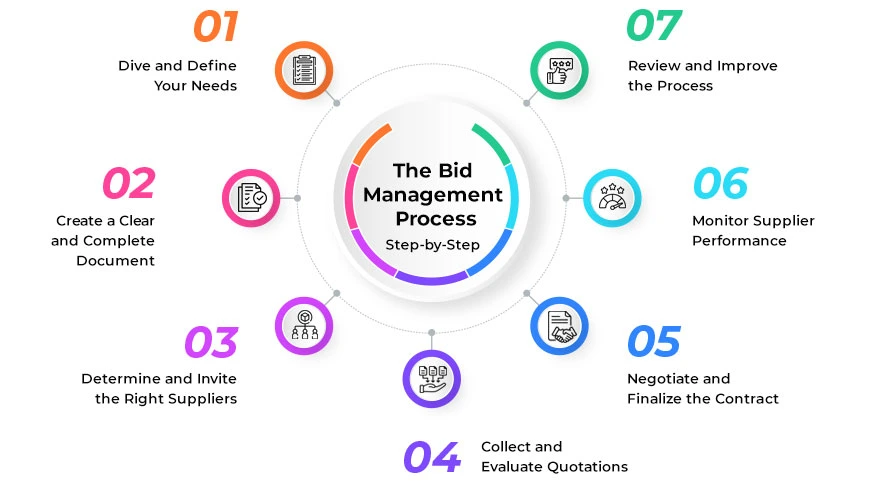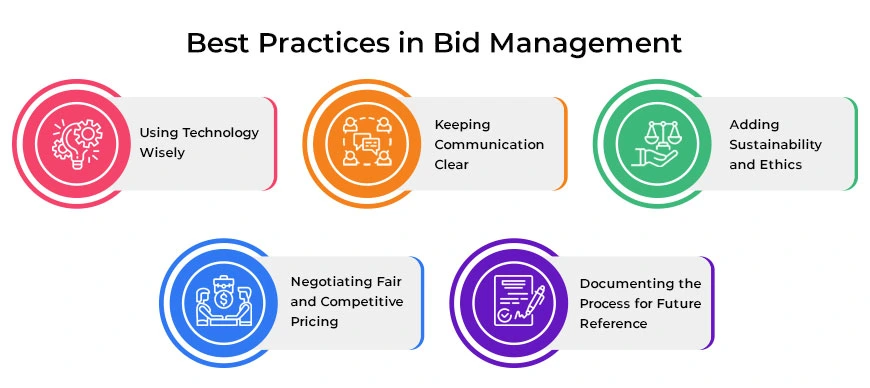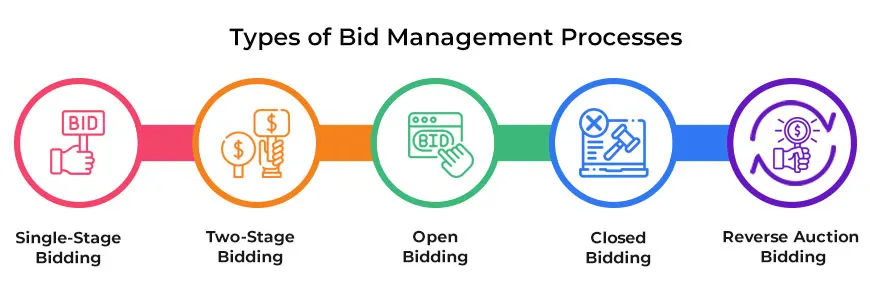Strategic Bid Management: A Comprehensive How-To Guide
You often found yourself buried in spreadsheets, missed deadlines and emails as managing multiple vendor quotations as a buyer. Your procurement process might be unorganized, leading to problems like inconsistent pricing, poor communication with suppliers, and delays in reviewing bids.
Applying the right bid management solution can prove a game changer for your business. In this guide you will understand what bid management is, how it implements it, and the best practices and strategies.
Let us know.
What is Bid Management?
Bid Management is the method of managing and organizing requests sent to suppliers to know the terms, price, delivery time and other details of goods or services which the company is considering buying.
It’s like asking multiple vendors for their best offers and then comparing them to pick the most suitable one based on price, quality, or delivery time.
What is Bid Management System?
Bid Management Software is digital software which is used to simplify and manage the bid processes. This tool allows buyers to keep the bidding process organized. It helps them to create bids, send them to suppliers, review the offer they get back and choose the best one.
The Bid Management Process: Step-by-Step

Let’s explore the key steps every buyer should follow to secure the best bid.
- Dive and Define Your Needs
Step one in managing a bid is to understand your needs. This merges details like how much volume you need to move, and how fast deliveries should be where the service is required. Having a crystal-clear list of main requirements can help you to find the right supplier. - Create a Clear and Complete Document
Your bid management document leads suppliers in preparing their quotations. It should clearly outline your service requirements, submission guidelines, evaluation criteria, contract terms, and contact details for clarifications. An accurate document secures a transparent bidding process, and it ultimately enhances relationships with suppliers. - Determine and Invite the Right Suppliers
The next step is to find potential suppliers who can meet your specific needs. Depending on your logistics scope, this could involve both regional and national service providers. Once selected, send them the bid management document with an invitation to participate. This extends your options and brings better pricing and service offerings. - Collect and Evaluate Quotations
As the bids start to come in, take the time to evaluate each one carefully. Don’t just focus on the price, look at the quality, the supplier’s reputation, their experience, and how well they meet your specific service needs. A thoughtful evaluation helps you choose a supplier who offers the best overall value, ensuring reliability and long-term success, not just a cheap price tag. - Negotiate and Finalize the Contract
Once you’ve identified the best supplier, initiate the negotiation process. Manage key factors such as pricing, service expectations, delivery timelines, penalty clauses, and any other operational details that are necessary. You have to assure both parties agree on the terms. After reaching an agreement, finalize the details and formally award the contract. - Monitor Supplier Performance
Your responsibility doesn’t stop at signing the contract. It’s important to monitor the supplier’s performance consistently to make sure that they meet your expectations. Schedule regular check-ins, provide constructive feedback, and make necessary adjustments to maintain the desired level of service quality. - Review and Improve the Process
Once the bid management process is complete, take time to review the entire cycle. Check on what worked well and identify areas for improvement. This evaluation helps refine your approach, will make your future bid processes more efficient and effective.
Best Practices in Bid Management

Following these best practices is crucial for securing an effortless and successful bid management process.
- Using Technology Wisely
Tools like e-sourcing software can help speed up and simplify the bid management process. They automate tasks such as collecting bids and handling supplier queries, making the process more efficient, transparent, and fair. - Keeping Communication Clear
Let the instructions clear and open communication with suppliers. Make sure timelines are realistic and all suppliers receive the same information, so everyone has a fair chance to participate. - Adding Sustainability and Ethics
Modern businesses are expected to act responsibly. Including sustainability and ethical standards in your tender management process shows that your company cares about the environment and society, which can improve your brand’s image. - Negotiating Fair and Competitive Pricing
Engage in open and constructive negotiations with suppliers to achieve competitive pricing. Look for opportunities to secure cost savings, value-added services, or volume discounts while ensuring the final price meets quality and requirement standards. - Documenting the Process for Future Reference
Keep comprehensive records of the entire bid management process, including all communication, submitted proposals, evaluation results, negotiations, and final contracts. This documentation serves as an important reference for future procurement activities, audits, and legal purposes.
Types of Bid Management Processes

- Single-Stage Bidding
This is the simplest format. The buyer shares all requirements upfront, and suppliers respond by submitting their pricing proposals based on those details. It’s a one-step process where everything happens in a single round. - Two-Stage Bidding
Here, the process is divided into two parts. In the initial stage, suppliers provide their qualifications and demonstrate their capabilities. The buyer evaluates this information and shortlists the most suitable vendors. Only those selected move on to the second stage, where they submit their final pricing. - Open Bidding
In this type, the opportunity is made public, allowing any qualified supplier to participate. This approach is ideal when buyers aim to tap into a broader vendor base, encourage healthy competition, and maintain full transparency throughout the process. - Closed Bidding
This approach limits participation to selected suppliers who are invited directly. These may be vendors with a proven track record or those who meet specific pre-qualification standards. Closed bids are often used for high-value or sensitive projects. - Reverse Auction Bidding
In this model, suppliers first submit their quotes. Then, a live bidding round takes place where they can lower their prices to win the contract. It encourages competitive pricing and drives better value for the buyer.
Bid and Tender Management Strategies
Bid management requires careful planning and precision. Here are some essential tips to ensure your bid management process runs efficiently and effectively:
- Clarify Your Requirements
Clear, well-defined requirements are important for a successful bid management process. When specifications are vague, it can lead to confusion and poor-quality proposals.
To get the most accurate and relevant bids, be specific about your needs, whether it’s product details, service expectations, or quality standards. The clearer you are, the easier it will be to compare the proposals you receive.
- Set Achievable Deadlines
While it’s interesting to rush the bidding process, unrealistic deadlines can lead to impulsive proposals from suppliers. This can compromise the quality of the bids.
But make sure to set reasonable timelines for suppliers to submit their proposals. Allow enough time to them so that they can deliver the best possible response, and you can carefully evaluate each one.
- Look Beyond Price
While cost is an important factor in bid evaluation, it shouldn’t be the only one. Choosing the lowest price may seem appealing, but it can often lead to compromises in quality, delivery timelines, or service reliability. That’s why it’s essential to evaluate the overall value each supplier brings.
Consider their ability to meet your specific needs, the quality of their products or services, the proposed pricing, any associated risks like product performance or financial stability, and their track record in terms of reliability and sustainability. Taking a balanced approach helps ensure smarter, long-term procurement decisions.
Common Challenges of Bid Management

- Unclear Specifications
When the bid document lacks clear or detailed requirements, suppliers may misunderstand what’s needed and submit inaccurate proposals. Precise specifications help suppliers provide more accurate and relevant quotations. - Low Supplier Participation
Attracting enough qualified suppliers to participate can be difficult. A limited number of bidders reduces competition, which may lead to higher costs and fewer options in terms of quality and innovation. - Time-Consuming Evaluation
Reviewing and comparing multiple supplier proposals can be a long and complex process. Without well-defined selection criteria and streamlined evaluation methods, choosing the best supplier becomes inefficient and prone to bias. - Complex Negotiation and Contracting
Once a supplier is selected, aligning on contract terms can be challenging—especially if multiple parties are involved. Finalizing fair agreements while balancing both sides’ interests often requires careful negotiation. - Difficulty Managing Changes
If there are changes in project scope, timelines, or requirements during the bidding process, it can lead to confusion among suppliers. To avoid miscommunication, it’s crucial to manage these updates clearly and fairly.
Tools & Software for Bid Management
Beyond Intranet’s #1 Bid Management Software
Beyond Intranet’s Bid Management Software is SOC2 compliant RFQ management software designed to boost your bid management process. It is built directly on the Microsoft SharePoint platform. You can automate your tender or bid management with SharePoint solution, it seamlessly connects with the Microsoft tools your team already relies on, creating a secure and efficient workspace customized for effortless collaboration.
Key Features:
- Ratings & Reviews: Microsoft AppSource: 4.9/5 (50+ reviews).
- RFQ Management – AI for Generation: AI streamlines RFQ creation by auto-filling product details, quantities, and timelines using historical data, cutting manual work and errors.
- Purchase Recognition: It is an inner document used to request goods or services, initiating the procurement process within an organization.
- Auction Management (Reverse and Forward): It handles reverse and forward auctions, enabling competitive bidding to secure the best pricing and terms from suppliers.
- Vendor Management: Optimizes supplier relationships, tracking performance, ensuring compliance, and fostering collaboration to enhance efficiency and reduce costs.
- Centralized Vendor Management: Maintain a comprehensive vendor database with contact information, separate vendor portal with intuitive dashboard, and compliance documentation.
- Automated Quote Comparison & Evaluation: AI compares supplier quotes by analyzing price, quality, and delivery terms, enabling faster, data-driven supplier evaluation and decision-making.
- Real-Time Collaboration: Easily chat with vendors within the platform to cut down email clutter and keep everything transparent.
Jaggaer – Best for E-Procurement
Jaggaer focuses on e-procurement, providing features for compliance and efficient purchasing. However, some users have noted that its global procurement capabilities are limited, especially when compared to the extensive, worldwide reach offered by Beyond Intranet’s Bid Management Software.
- Key Features: E-procurement, supply chain optimization, supplier relationship management, and intelligent sourcing.
- Ratings & Reviews: G2: 4.4/5 (27+ reviews), Capterra: 4.2/5 (2+ reviews).
Procurify – Best for Supplier Management
Procurify simplifies supplier and procure-to-pay management but lacks inventory features.
- Key Features: Supplier management, mobile app access, seamless accounting system integration, and customizable expense approval workflows.
- Ratings & Reviews: G2: 4.6/5 (170+ reviews), Capterra: 4.5/5 (140+ reviews).
Corcentric – Best for B2B Teams
Corcentric offers robust source-to-pay features but faces performance issues like slow speeds and occasional glitches compared to other platforms.
- Key Features: B2B commerce solutions, intelligent applications, strategic consulting, and managed services.
- Ratings & Reviews: G2: 3.2/5 (7+ reviews), Capterra: 4/5 (3+ reviews).
GEP SMART – Best for Direct Procurement
GEP SMART supports direct procurement well but is seen as less user-friendly and harder to implement than Beyond Intranet’s solution.
Key Features: Direct procurement, AI-powered automation, compliance management, end-to-end procurement.
Ratings & Reviews: G2: 4.4/5 (20+ reviews), Capterra: 4.6/5 (7 reviews).
If you want to explore more about the tools, then check out Top 10 RFQ management tool blog.
Conclusion
The Bid Management Process is essential for selecting the best supplier, considering factors such as price, quality, and reliability. By clearly defining expectations, evaluating bids thoroughly, and utilizing digital bid management tools, companies can optimize costs and enhance the procurement process.
Looking for an efficient way to secure the best deals and prices? Schedule a personalized demo with our Beyond Intranet team and gain access to a free one-week trial.






